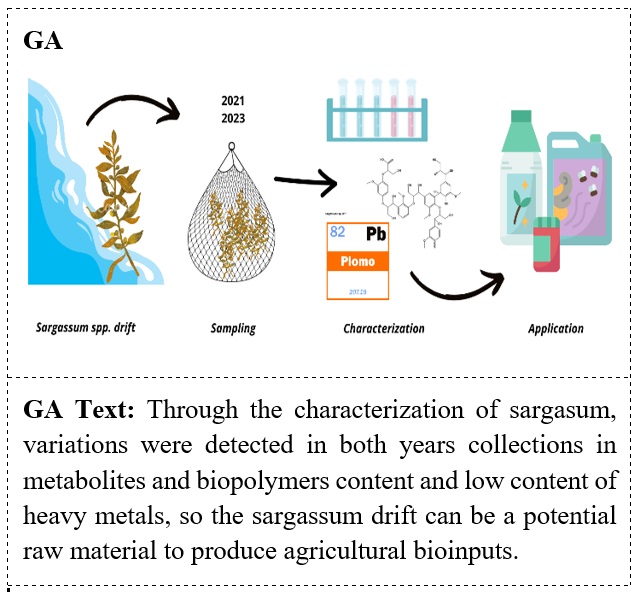Sargassum spp. de arribazón: caracterización y potencial uso agrícola
Palavras-chave:
biopolímeros; macroalgas; metabolitos; metales pesados; tamizaje fitoquímico.Resumo
En Cuba, el arribazón de sargazo pelágico no constituye un fenómeno de gran magnitud, sin embargo, es recurrente y no hay un manejo adecuado de esta biomasa, considerada como un residuo marino. El objetivo de esta investigación fue caracterizar sargazo recolectado en el litoral habanero en diciembre de 2021 y marzo de 2023, para detectar variaciones en su composición química y valorar la potencialidad de este residuo como materia prima para el desarrollo de insumos agrícolas. Las muestras colectadas se caracterizaron mediante tamizaje fitoquímico, propiedades físico-químicas y los contenidos de metales pesados y polímeros naturales. En ambas colectas se destaca la presencia de alcaloides, azúcares reductores, compuestos aminados y esteroides. Las características físico-químicas y el contenido de biopolímeros variaron entre colectas y la concentración de metales fue inferior al límite permisible. Los resultados hacen del sargazo una materia prima potencial para la producción de bioinsumos agrícolas (biofertilizantes, bioestimulantes o biomaterial).
Referências
WANG, M. et al. “The great Atlantic Sargassum belt”. Science. 2019. 365(6448), 83-87. DOI: 10.1126/science.aaw7912.
FIDAI, Y. A.; DASH, J.; TOMPKINS, E. L.; TONON, T. “A systematic review of floating and beach landing records of Sargassum beyond the Sargasso Sea”. Environ. Res. Commun. 2020. 2. 122001, 1-11 DOI: 10.1088/2515-7620/abd109.
PARDILHÓ, S. et al. “Back to the origins: Potential of beach-cast macroalgae as biofertilizer”. Waste and Biomass Valorization. 2022. 14, 1097-1111 DOI: 10.1007/s12649-022-01922-7.
TONON, T. et al. “Biochemical and elemental Composition of pelagic Sargassum biomass harvested across the Caribbean”. Phycology. 2022. 2, 204-215. DOI: 10.3390/phycology2010011.
MILLEDGE, J. J.; MANEEIN, S.; ARRIBAS, E.; BARTLETT, D. “Sargassum Inundations in Turks and Caicos: Methane Potential and Proximate, Ultimate, Lipid, Amino Acid, Metal and Metalloid Analyses”. Energies. 2020. 13, 1523. DOI: 10.3390/en13061523.
CRAIGIE, J. S. “Seaweed extract stimuli in plant science and agriculture”. J ApplPhycol. 2011. 23, 371-393. DOI: 10.1007/s10811-010-9560-4.
ESPINOSA ANTÓN, A. A.; HERNÁNDEZ-HERRERA, R. M.; GONZÁLEZ GONZÁLEZ, M. “Bioactive seaweed extracts as biostimulants of growth and protection of plants”. Biot. Veg. 2020. 20(4), 257-282. ISSN: 2074-8647.
PUGLIA, D. et al. “The Opportunity of Valorizing Agricultural Waste Through Its Conversion into Biostimulants, Biofertilizers and Biopolymers. Sustainability. 2021. 13, 2710. DOI: 10.3390/su13052710.
RONDINA, R. V.; COUSSIO, J. D. “Estudio Fitoquímico de Plantas Medicinales”. Rev. Invest. Agropec. 1969. 6(2), 352–66.
WORLD HEALTH ORGANIZATION. Quality control methods for medicinal plant materials. Geneva.1998. ISBN 92 4 154510 0 (NLM Classification: QV 766). URL: http://www.who.int/docs/default-source/medicines/ norms-and-tandards/guidelines/quality-control/ quality-control-methods-for-medicinal-plant-materials.pdf?sfvrsn=b451e7c6_0
GÓMEZ, ORDÓÑEZ, E. Evaluación nutricional y propiedades biológicas de algas marinas comestibles. Estudios in vitro e in vivo. Tesis doctoral. Universidad Complutense de Madrid. España, 2013. Disponible en: http://api.semanticscholar.org/CorpusID:82051863
MAHYATI, A. R.; PATONG, M. N.; DJIDE, D.; TABA, P. “Biodegradation of lignin from corn cob by using a mixture of Phanerochaete chrysosporium, Lentinus edodes and Pleurotus ostreatus”. International Journal of Scientific & Technology Research. 2013. 2(11), 79-82. ISSN 2277-8616.
PONCE, L. R.; DEL BARRIO, G. C.; SPENGLER, I.; RESIK, S.; ROQUE, A. “Evaluation of the antiviral activity of the brown algae Sargassum fluitans against Echovirus 9”. Rev. Med. Tropical. 2018. 70(2), 1-10. ISSN: 1561-3054 (Electrónico). https://www.medigraphic.com/cgibin/new/resumenI.cgi?IDARTICULO=83837
PRASEDYA, E. S. et al. “Effect of particle size on phytochemical composition and antioxidant properties of Sargassum cristaefolium etanol extract”. Scientific Reports. 2021. 11:17816. DOI: 10.1038/s41598-021-95769-y.
MARIMUTHU, J. et al. “Phytochemical characterization of brown seaweed Sargassumwightii”. Asian Pacific Journal of Tropical Disease. 2012. 2(Sup 1), S109-S113. DOI: 10.1016/S2222-1808(12)60134-0.
AMUTHA, J.; SATHIYA, G.; PERIYANAYAGAM, K. “Pharmacognostical study and phytochemical evaluation of brown seaweed Sargassumwightii”. Journal of Coastal Life Medicine. 2013. 1(3), 199-204. DOI: 10.12980/JCLM.1.2013C959.
SAMI, F.; YUSUF, M.; FAIZAN, M.; FARAZ, A.; HAYAT, S. “Role of sugars under abiotic stress”. Plant Fisiology and Biochemistry. 2016. 109, 54-61 DOI: 10.1016/j.plaphy.2016.09.005.
AI, N. et al. “Rapid Measurement of Cellulose, Hemicellulose and Lignin Content in Sargassum horneri by Near-Infrared Spectroscopy and Characteristic Variables Selection Methods”. Molecules. 2022. 27(335), 1-17. DOI: 10.3390/molecules2702335.
CUI, C. J. et al. “Insecticidal Activity and Insecticidal Mechanism of Total Saponins from Camellia oleifera”. Molecules. 2019. 24, 4518. DOI: 10.3390/molecules24244518.
MITHÖFER, A.; BOLAND, W. “Plant Defense Against Herbivores: Chemical Aspects”. Annu. Rev. Plant Biol. 2012. 63, 431-50. DOI: 10.1146/annurev-arplant-042110-103854.
AGUILERA, L. E.; CHANDÍA, N. P.; NEEDHAM, P.; Álvarez, C. “Efecto de polímeros algales sobre la productividad de uva bajo condiciones de riego deficitario”. Información Tecnológica. 2021. 32(5),29-36. DOI: 10.4067/S0718-07642021000500029.
SALGADO, E. et al. “Energy-saving pretreatments affect pelagic Sargassum composition and DNA metabarcoding reveals the microbial community involved in methane yield”. PLoS One. 2023. 18(8):e0289972. DOI: 10.1371/journal.pone.0289972.
PIÑA, J. J.; BALBÍN, A. I.; PÉREZ-CORDOVÉS, A. I. “La contaminación por metales pesados en sargazos procedentes de la costa sur en la península de Guanahacabibes”. Revista Cubana de Química. 2010. XXII (1), 83-88. ISSN: 0258-5995.
LÄHTEENMÄKI, A. et al. “European Union legislation on macroalgae product”. Aquaculture International. 2021. 29, 487-509. DOI: 10.1007/s10499-020-00633-x.
SAVY, D.; COZZOLINO, V.; VINCI, G.; NEBBIOSO, A.; PICCOLO, A. “Water-Soluble Lignins from Different Bioenergy Crops Stimulate the Early Development of Maize (Zea mays L.)”. Molecules. 2015. 20: 19958-19970. DOI: 10.3390/molecules201119671.

Downloads
Publicado
Como Citar
Edição
Seção
Licença
Copyright (c) 2024 Amalia de la C. Díaz-Prieto, Kiara Zulueta-Prado, Orbel A. Marrero-Pérez, Mislén Gómez-Matos, Dariellys Martínez-Balmori

Este trabalho está licenciado sob uma licença Creative Commons Attribution-NonCommercial-NoDerivatives 4.0 International License.
Esta revista oferece acesso aberto imediato ao seu conteúdo, com base no princípio de que oferecer ao público o acesso gratuito à pesquisa contribui para uma maior troca global de conhecimento.






















